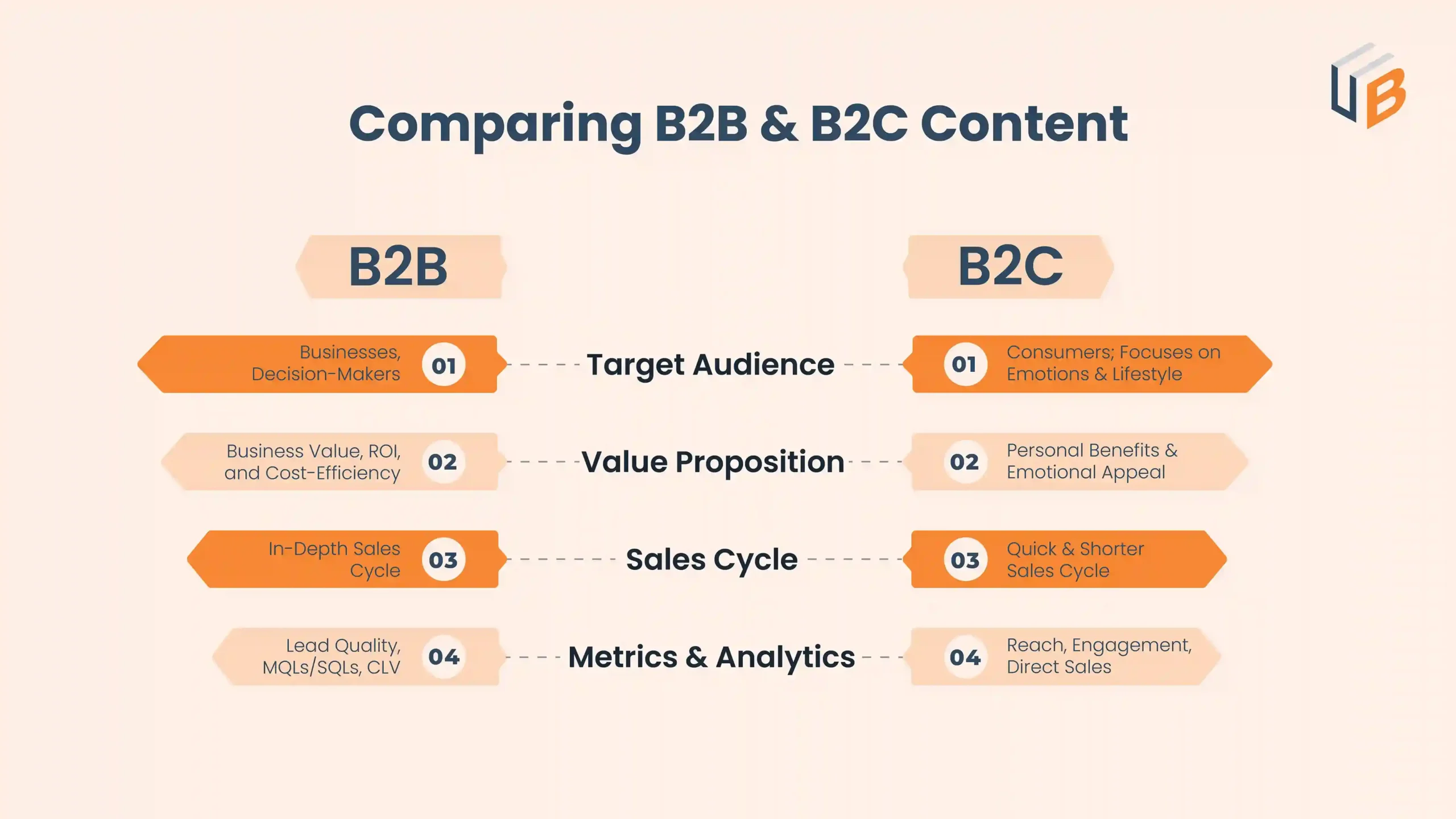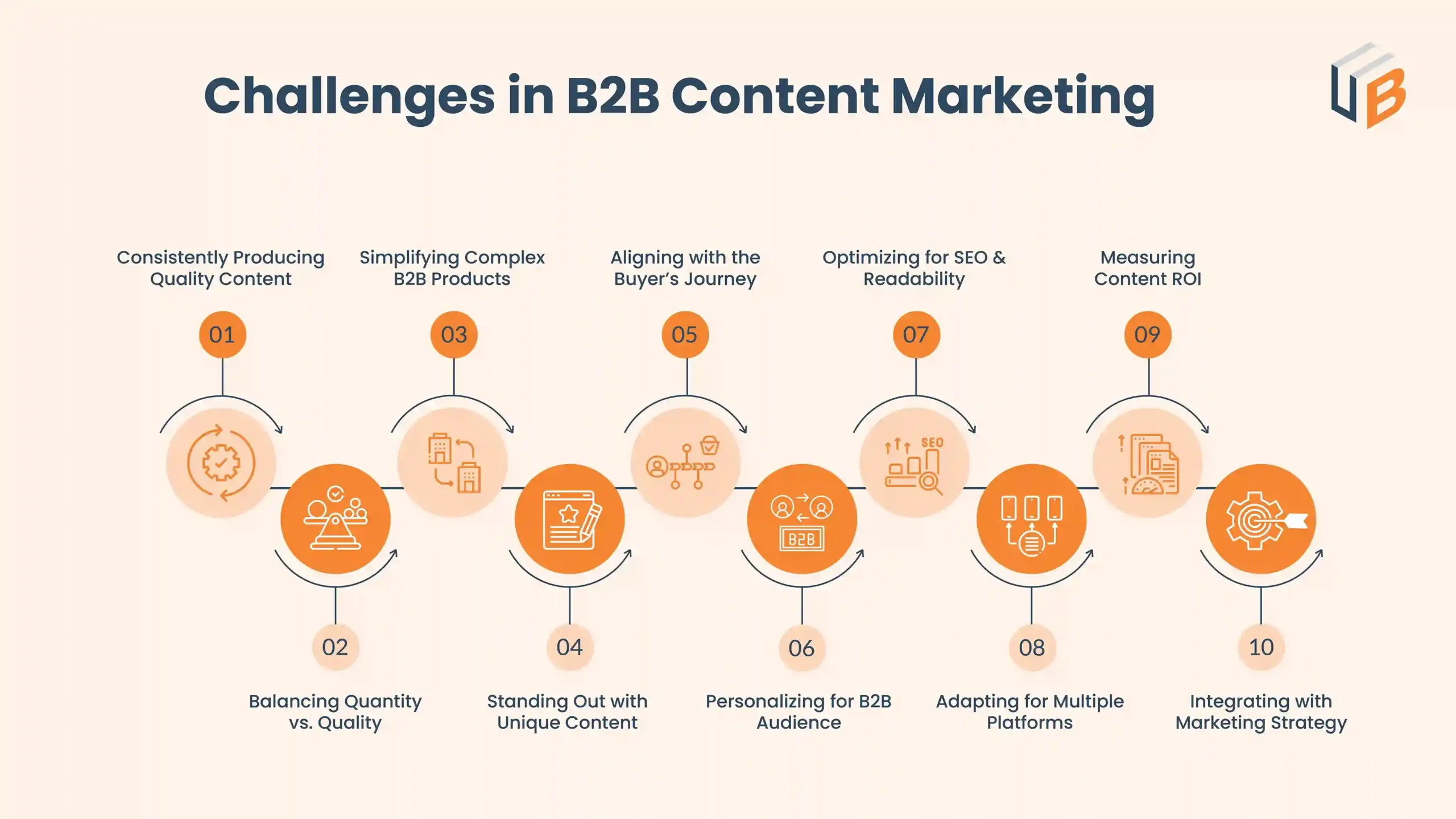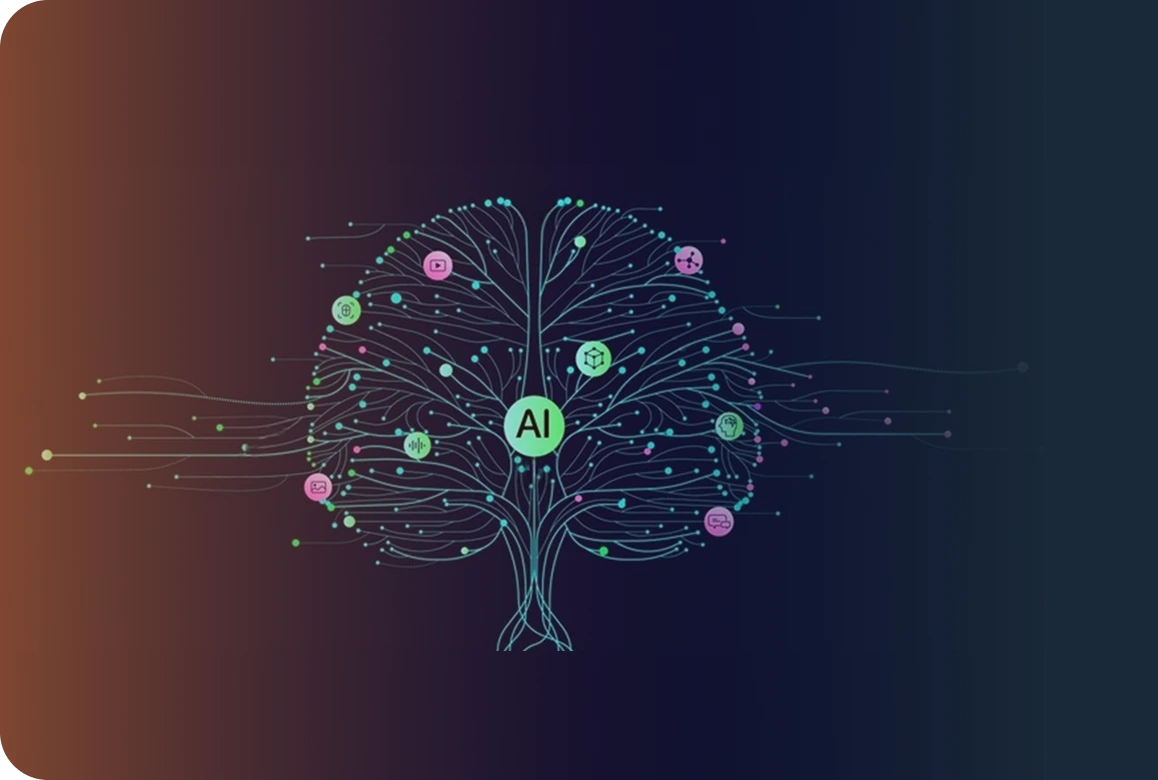
B2B content marketing is essential for businesses to establish authority, generate leads, and drive growth.
Unlike B2C content marketing, which targets individual consumers, B2B content marketing focuses on addressing the unique needs and challenges of other businesses.
According to the Content Marketing Institute’s study, 84% of B2B marketers saw increased brand awareness, 76% improved lead generation, and 58% higher sales, all because of content marketing. This highlights the effectiveness of B2B content marketing and its growing importance in the business landscape.
However, B2B content marketing comes with its own set of unique challenges. From creating engaging content for complex products to measuring ROIs accurately, marketers face numerous hurdles.
In this blog, we’ll explore the key differences between B2B and B2C content marketing. We’ll then dive into 10 specific challenges that B2B marketers often encounter. Also, we’ll equip you with practical strategies to overcome these obstacles, so you can craft effective B2B content strategies and drive meaningful business results.
B2B vs B2C Content Marketing: How Are They Different
While both B2B and B2C content marketing aim to engage audiences, they differ significantly in approach and execution. Let’s explore four key differences that set these strategies apart.

1. Target Audience
B2B content marketing targets businesses and professional decision-makers, often involving multiple stakeholders in the purchasing process. These audiences seek in-depth information, industry expertise, and solutions to specific business challenges. B2B content addresses complex needs, demonstrates a deep understanding of industry trends, and speaks to various roles within an organization.
In contrast, B2C content marketing targets individual consumers, focusing on personal needs, emotions, and lifestyle factors. B2C content is typically more broadly appealing, emotionally driven, and designed to resonate with individual preferences and desires.
2. Value Proposition
B2B content marketing focuses on demonstrating business value, efficiency, and return on investments (ROIs). The content often emphasizes how products or services can solve specific business problems, increase productivity, or reduce costs. It’s typically more rational and data-driven, highlighting features, specifications, and long-term benefits.
On the other hand, B2C content marketing emphasizes on personal benefits, emotional appeal, and immediate gratification. It often focuses on how products or services can improve the consumer’s life, make them feel better, or solve personal problems. B2C value propositions are usually simpler and more emotionally driven than B2B.
3. Sales Cycle
B2B content marketing typically supports longer sales cycles, often spanning months or even years for major purchases. This extended process requires content that nurtures leads through personalized, data-driven interactions at each stage of the buyer’s journey. B2B content often includes in-depth ebooks, case studies, and detailed product comparisons to support thorough evaluation.
Conversely, B2C content marketing usually deals with shorter sales cycles. Consumers often make quicker decisions based on less information. B2C content creates immediate interest and desire, often focusing on promotions, product highlights, and lifestyle benefits to encourage faster purchase decisions.
4. Metrics and Analytics
B2B content marketing metrics often focus on lead quality, sales pipeline influence, and customer lifetime value. Key performance indicators (KPIs) include Marketing Qualified Leads (MQLs), Sales Qualified Leads (SQLs), and conversion rates at different stages of the sales funnel. B2B marketers often track engagement with specific pieces of content to understand their impact on the sales process.
In contrast, B2C content marketing metrics typically focus on reach, engagement, and direct sales impact. KPIs often include website traffic, social media engagement, conversion rates, and average order value. B2C marketers focus more on immediate consumer actions and brand awareness metrics.
Now that you understand the difference between B2B and B2C content marketing, let’s jump into the challenges in B2B content marketing.
10 B2B Content Marketing Challenges

1. Consistently Producing High-Quality Content
Creating high-quality content consistently means crafting engaging and informative pieces that resonate with B2B audiences. This requires a good grasp of complex industry topics, which can be quite demanding in terms of time and resources.
The challenge lies in keeping up with content demands without letting quality slip. Juggling this with other tasks can lead to inconsistencies, and if the content isn’t up to par, it can hurt your credibility and connection with your audience.
To tackle this, set up a content calendar to keep track of topics and deadlines. Utilize content syndication, which involves adapting existing content into different formats and distributing it across various platforms. This helps in extending reach and engagement without the need for constant new content creation.
2. Balancing Content Quantity and Quality
Balancing content quantity and quality is about finding the perfect balance between producing enough content to stay relevant and ensuring each piece is valuable and engaging.
If you publish too much content, you risk diluting your message or putting out subpar material. And if you focus solely on crafting perfect pieces, you might post so infrequently that your audience forgets you exist.
To strike the right balance, prioritize a content strategy that focuses on both quantity and quality. Use a content calendar to plan and space out your posts, ensuring each one is well-researched and thoughtfully crafted. Also, leverage user-generated content to supplement your original content production.
3. Creating Content for Complex B2B Products/Services
B2B products and services are often complex, making it challenging to create content that’s both informative and engaging.
Overtly technical content may alienate your audience, while overly simplistic content might fail to convey the full value of your offering.
To address this, use analogies and real-world examples to simplify complex concepts. Incorporate visual content such as infographics or explainer videos to make information more digestible.
4. Creating Differentiating Content
B2B content space is crowded with many businesses producing similar content. And with so much content available, it’s easy for your message to get lost in the noise.
Without a clear way to stand out, it can be tough for your brand to get noticed. This can reduce your effectiveness when connecting with potential clients.
To overcome this, focus on identifying your unique value proposition and weaving it into your content. Highlight your expertise, share original insights, and use storytelling to connect with your audience on a personal level. Also, experiment with different formats and channels to reach your audience in new and engaging ways.
5. Aligning Content with the Buyer’s Journey
Aligning content with the buyer’s journey involves creating material that meets the needs of your audience at each stage of their decision-making process.
If your content doesn’t resonate with where your audience are in their journey, it may fail to engage or convert them. Mismatched content can lead to missed opportunities as potential clients might not find the information they need to move forward.
To address this, develop a content strategy that maps content to each stage of the buyer’s journey:
- Awareness: Create blog posts, social media posts, and podcasts.
- Consideration: Craft eBooks, comparison guides, and case studies.
- Decision: Create product demos, customer testimonials, and pricing pages.
Also, regularly review and adjust your content strategy so it remains relevant and effective.
6. Personalizing Content for B2B Audience Segments
Personalizing B2B content means crafting messages tailored to the specific needs and preferences of different audience segments. This requires a deep understanding of their characteristics, challenges, and goals.
Without personalization, your content might come across as generic and fail to engage your audience effectively. B2B buyers expect information that is relevant and directly applicable to their situations. If your content lacks personalization, it can lead to decreased engagement and fewer conversions.
To tackle this, start by segmenting your audience based on criteria like industry, company size, or role. Use a data-driven approach to develop content that meets the unique needs of each segment. Implement Account-Based Marketing (ABM) and create tailored email campaigns that truly resonate with each group.
7. Optimizing Content for Both SEO and Readability
Balancing SEO and readability involves making your content easy for search engines to find and engaging for people to read. This means you need to integrate keywords and SEO tactics without making your writing hard to follow.
The tricky part is that stuffing your content with too many keywords can make it difficult for the audience to read. On the flip side, if you focus only on making it readable, it might not rank well in search results, which means fewer people will see it.
To get this right, conduct keyword research to find relevant keywords and incorporate them naturally into your content. Use headings and short paragraphs to enhance readability. And most importantly, make sure your content answers your audience’s questions, benefiting both SEO and user engagement.
8. Adapting Content for Multiple Platforms
Content that works on one platform might not work on another because each platform has its own unique characteristics and user expectations.
Take, for instance, a detailed article, it might be perfect for a blog but could fall flat on LinkedIn. Similarly, long videos tend to do well on YouTube while shorter ones are more popular on Instagram.
To fix this, discover where your audience spends their time online and tweak your content to fit those spaces. Customize your message to match the style of each platform. Also, ensure your content stays consistent and engaging everywhere.
9. Measuring Content Marketing ROI
Measuring content marketing ROI is essential to understand which pieces contribute to your goals. However, this can be tricky because the impact of content isn’t always immediate or directly measurable.
Also, content marketing involves a lot of different metrics like how many people are engaging with your content or how many leads you’re generating. This makes it tough to see which efforts are making a difference.
To tackle this, set clear goals and key performance indicators (KPIs) for your content. Use analytics tools to track performance and gather data on metrics like conversion rates and lead quality. Regularly review these insights to adjust your strategy and demonstrate the value of your content efforts.
10. Integrating Content with Overall Marketing Strategy
Your content must go hand-in-hand with your overall marketing strategy to create a unified brand message and get the most out of your marketing efforts.
But sometimes, your content operates in a silo, disconnected from advertising, social media, or sales. When this happens, your messaging might become inconsistent and you could miss out on opportunities to use your content effectively across different platforms.
To address this, align your content goals with your overall marketing objectives. Collaborate with other teams to ensure that content supports initiatives across the board. Regularly review and tweak your content strategy to fit well with your overall marketing plans.
Take Your Content Marketing Game to the Next Level
You’ve explored the key challenges in B2B content marketing and learned strategies to overcome them. Now it’s time to put these insights into action.
Start by assessing your current content strategy and identifying areas for improvement. Whether it’s enhancing personalization, optimizing for SEO, or aligning content with your overall marketing goals, each step will bring you closer to achieving impactful results.
Remember, the B2B content space is ever-evolving, so stay flexible, be open to new ideas, and adapt as needed.
Now, go ahead and implement these strategies and watch your B2B content marketing efforts drive meaningful business growth.
Our blog
Latest blog posts
Tool and strategies modern teams need to help their companies grow.

Master lead scoring by buyer journey stage to qualify faster, predict intent, and con...

Discover the top 10 B2B appointment setting companies in the USA offering expert-led,...

Discover how AI Overviews are transforming B2B demand generation and how marketers ca...





